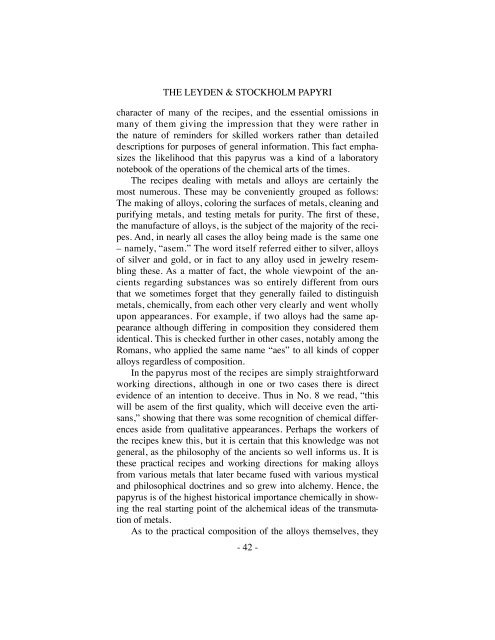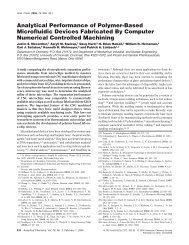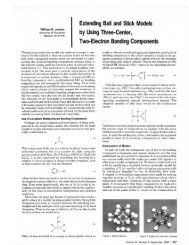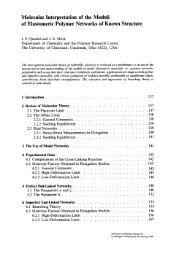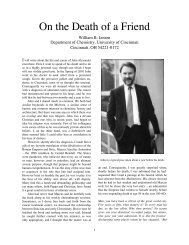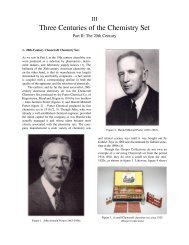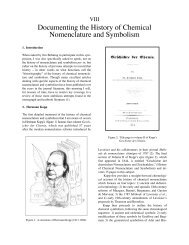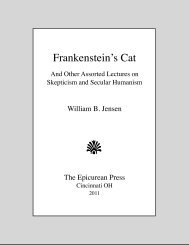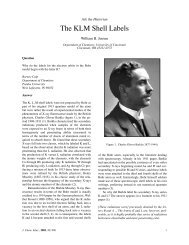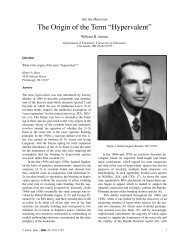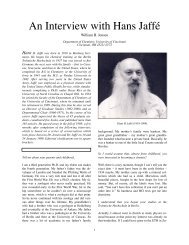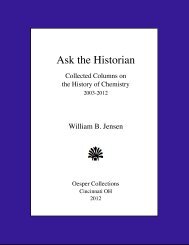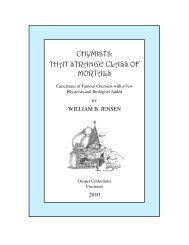The Leyden and Stockholm Papyri - University of Cincinnati
The Leyden and Stockholm Papyri - University of Cincinnati
The Leyden and Stockholm Papyri - University of Cincinnati
Create successful ePaper yourself
Turn your PDF publications into a flip-book with our unique Google optimized e-Paper software.
THE LEYDEN & STOCKHOLM PAPYRI<br />
character <strong>of</strong> many <strong>of</strong> the recipes, <strong>and</strong> the essential omissions in<br />
many <strong>of</strong> them giving the impression that they were rather in<br />
the nature <strong>of</strong> reminders for skilled workers rather than detailed<br />
descriptions for purposes <strong>of</strong> general information. This fact emphasizes<br />
the likelihood that this papyrus was a kind <strong>of</strong> a laboratory<br />
notebook <strong>of</strong> the operations <strong>of</strong> the chemical arts <strong>of</strong> the times.<br />
! <strong>The</strong> recipes dealing with metals <strong>and</strong> alloys are certainly the<br />
most numerous. <strong>The</strong>se may be conveniently grouped as follows:<br />
<strong>The</strong> making <strong>of</strong> alloys, coloring the surfaces <strong>of</strong> metals, cleaning <strong>and</strong><br />
purifying metals, <strong>and</strong> testing metals for purity. <strong>The</strong> first <strong>of</strong> these,<br />
the manufacture <strong>of</strong> alloys, is the subject <strong>of</strong> the majority <strong>of</strong> the recipes.<br />
And, in nearly all cases the alloy being made is the same one<br />
– namely, “asem.” <strong>The</strong> word itself referred either to silver, alloys<br />
<strong>of</strong> silver <strong>and</strong> gold, or in fact to any alloy used in jewelry resembling<br />
these. As a matter <strong>of</strong> fact, the whole viewpoint <strong>of</strong> the ancients<br />
regarding substances was so entirely different from ours<br />
that we sometimes forget that they generally failed to distinguish<br />
metals, chemically, from each other very clearly <strong>and</strong> went wholly<br />
upon appearances. For example, if two alloys had the same appearance<br />
although differing in composition they considered them<br />
identical. This is checked further in other cases, notably among the<br />
Romans, who applied the same name “aes” to all kinds <strong>of</strong> copper<br />
alloys regardless <strong>of</strong> composition. !<br />
! In the papyrus most <strong>of</strong> the recipes are simply straightforward<br />
working directions, although in one or two cases there is direct<br />
evidence <strong>of</strong> an intention to deceive. Thus in No. 8 we read, “this<br />
will be asem <strong>of</strong> the first quality, which will deceive even the artisans,”<br />
showing that there was some recognition <strong>of</strong> chemical differences<br />
aside from qualitative appearances. Perhaps the workers <strong>of</strong><br />
the recipes knew this, but it is certain that this knowledge was not<br />
general, as the philosophy <strong>of</strong> the ancients so well informs us. It is<br />
these practical recipes <strong>and</strong> working directions for making alloys<br />
from various metals that later became fused with various mystical<br />
<strong>and</strong> philosophical doctrines <strong>and</strong> so grew into alchemy. Hence, the<br />
papyrus is <strong>of</strong> the highest historical importance chemically in showing<br />
the real starting point <strong>of</strong> the alchemical ideas <strong>of</strong> the transmutation<br />
<strong>of</strong> metals.<br />
! As to the practical composition <strong>of</strong> the alloys themselves, they<br />
- 42 -


